The Prophet was a local Latter Day Saint newspaper published in New York City, New York, United States. The first editor of the paper was William Smith and the periodical was printed from 1844 to 1845. [1]
The paper was likely founded as part of Joseph Smith's presidential campaign. It resembled other contemporary Mormon newspapers, from which it often published excerpts. [2] Other editors included George T. Leach, Samuel Brannan, A. E. Wright, and Parley P. Pratt. [3] In July 1845 the paper's format and name changed to become the New-York Messenger, which lasted until the end of the year. [4]
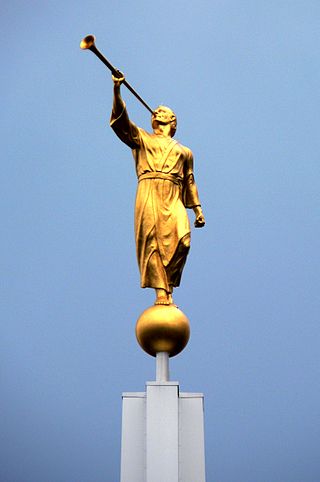
The Angel Moroni is an angel whom Joseph Smith reported as having visited him on numerous occasions, beginning on September 21, 1823. According to Smith, the angel was the guardian of the golden plates, buried in the hill Cumorah near Smith's home in western New York; Latter Day Saints believe the plates were the source material for the Book of Mormon. An important figure in the theology of the Latter Day Saint movement, Moroni is featured prominently in Mormon architecture and art. Besides Smith, the Three Witnesses and several other witnesses also reported that they saw Moroni in visions in 1829.

Samuel Brannan was an American settler, businessman, journalist, and prominent Mormon who founded the California Star, the first newspaper in San Francisco, California. He is considered the first to publicize the California Gold Rush and was its first millionaire. He used the profits from his stores to buy large tracts of real estate. He helped form the first vigilance committee in San Francisco and was disfellowshiped from the Church of Jesus Christ of Latter-day Saints because of his actions within the vigilance committee. Brannan's wife divorced him and he was forced to liquidate much of his real estate to pay her one-half of their assets. He died poor and in relative obscurity.

Oliver H. P. Cowdery was an American Mormon leader who, with Joseph Smith, was an important participant in the formative period of the Latter Day Saint movement between 1829 and 1836. He was the first baptized Latter Day Saint, one of the Three Witnesses of the Book of Mormon's golden plates, one of the first Latter Day Saint apostles, and the Second Elder of the church.

Times and Seasons was a 19th-century Latter Day Saint newspaper published at Nauvoo, Illinois. It was printed monthly or twice-monthly from November 1839 to February 1846. The motto of the paper was "Truth will prevail," which was printed underneath the title heading. It was the successor to the Elders' Journal and was the last newspaper published by the Church in the United States before the schisms that occurred after the death of Joseph Smith.

The Evening and the Morning Star was an early Latter Day Saint movement newspaper published monthly in Independence, Missouri, from June 1832 to July 1833, and then in Kirtland, Ohio, from December 1833 to September 1834. Reprints of edited versions of the original issues were also published in Kirtland under the title Evening and Morning Star.

The Latter Day Saints' Messenger and Advocate, often shortened to Messenger and Advocate, was an early Latter Day Saint monthly newspaper published in Kirtland, Ohio, from October 1834 to September 1837. It was the successor to The Evening and the Morning Star and the predecessor to the Elders' Journal.
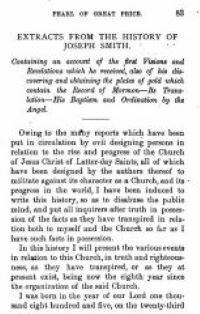
Joseph Smith–History is a book in the Pearl of Great Price containing excerpts from an autobiographical record of some of the early events in the life of Joseph Smith, the founder of the Latter Day Saint movement. Like many of Smith's publications, it was dictated to scribes.
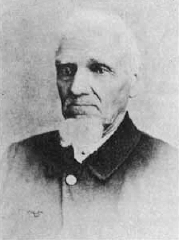
William Smith was a leader in the Latter Day Saint movement and one of the original members of the Quorum of the Twelve Apostles. Smith was the eighth child of Joseph Smith Sr. and Lucy Mack Smith and was a younger brother of Joseph Smith Jr., the founder of the Latter Day Saint movement.
A Rigdonite is a member of the Latter Day Saint movement who accepts Sidney Rigdon as the successor in the church presidency to the movement's founder, Joseph Smith Jr. The early history of the Rigdonite movement is shared with the history of the Latter Day Saint movement, but as of the 1844 succession crisis becomes distinct. Sidney Rigdon and other church leaders, including Brigham Young and James J. Strang, presented themselves as leaders of the movement and established rival church organizations. Rigdon's group was initially headquartered in Pittsburgh, Pennsylvania. It was known at one point as the Church of Jesus Christ of the Children of Zion, and its adherents are referred to as Rigdonites, or sometimes "Pennsylvania Latter Day Saints" or "Pennsylvania Mormons." The only surviving organization that traces its succession back to Rigdon's organizations is The Church of Jesus Christ, founded by a group of Rigdon's followers led by William Bickerton.

The Elders' Journal of the Church of Latter Day Saints was an early Latter Day Saint periodical edited by Don Carlos Smith, younger brother of Joseph Smith. It was the successor to the Latter Day Saints' Messenger and Advocate and was eventually replaced by the Times and Seasons.

The Latter-day Saints’ Millennial Star was the longest continuously published periodical of the Church of Jesus Christ of Latter-day Saints, and was printed in England from 1840 until 1970, when it was replaced by the church-wide Ensign. It was primarily aimed at British Latter-day Saints.

History of Joseph Smith by His Mother is a biography of Joseph Smith, founder of the Latter Day Saint movement, according to his mother, Lucy Mack Smith. It was originally titled Biographical Sketches of Joseph Smith, the Prophet, and His Progenitors for Many Generations and was published by Orson Pratt in Liverpool in 1853.

Prophwyd y Jubili was a Welsh language monthly periodical of the Church of Jesus Christ of Latter Day Saints between 1846 and 1848. It was the first Latter Day Saint periodical that was published in a language other than English.
Don Carlos Smith was the youngest brother of Joseph Smith and a leader, missionary, and periodical editor in the early days of the Latter Day Saint movement.
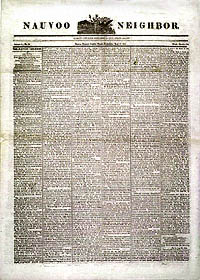
The Nauvoo Neighbor was a weekly newspaper edited and published by Latter Day Saint apostle John Taylor in Nauvoo, Illinois, from 1843 to 1845. While it was not an official publication of the Church of Jesus Christ of Latter Day Saints, the Neighbor was consistently pro-Mormon and its primary target audience was the Latter Day Saint residents of Nauvoo. When The Wasp ceased publication in April 1843, the Neighbor replaced it as Nauvoo's premier secular newspaper.
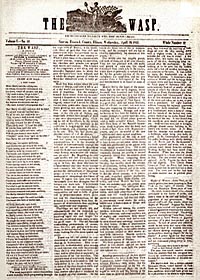
The Wasp was a weekly Latter Day Saint newspaper edited and published by William Smith in Nauvoo, Illinois, from April 1842 to April 1843. While it was not an official publication of the Church of Jesus Christ of Latter Day Saints, The Wasp was consistently pro-Mormon and its primary target audience was the Latter Day Saint residents of Nauvoo. The Wasp ceased publication when it was replaced by John Taylor's similarly themed Nauvoo Neighbor.
Abner Cole, also known by his pen name Obadiah Dogberry, Esq., was a 19th-century American newspaper editor. He was one of the earliest critics of the spiritual claims of Joseph Smith, the founder of the Latter Day Saint movement, having commented on the "Golden Bible" before it was even published as the Book of Mormon. Cole's publishing philosophy was one of freethought, which flourished in periodicals in the northeastern United States between 1825 and 1850.

The Church of Jesus Christ of Latter-day Saints in Wales refers to the Church of Jesus Christ of Latter-day Saints and its members in Wales.

The John Whitmer Historical Association (JWHA) is an independent, nonprofit organization promoting study, research, and publishing about the history and culture of the Latter Day Saint movement. It is especially focused on the Community of Christ, other midwestern Restoration traditions, and early Mormonism. The Community of Christ's approach to its own history was influenced, in part, by historical problems raised and explored through JWHA publications and conferences, and those of its sister organization, the Mormon History Association. JWHA membership numbers around 400 and is open to all, fostering cooperation with LDS and non-Mormon scholars.